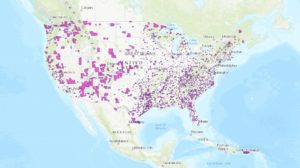Qualified opportunity zones are census tracts in all 50 states, all U.S. territories and Washington D.C. that have been designated by their respective governors as low income or economically distressed areas, and thus eligible for tax deferred investment through qualified opportunity zone funds.
As we’ll discuss in the following article, investors can roll unrealized capital gains into qualified opportunity zone funds and defer taxation until the investment is sold.
Furthermore, there are additional tax exemptions on the appreciation of the opportunity fund investment itself, based on a sliding scale with benefits increasing as the length of the hold period increases.
The Opportunity Zone program was created by the Tax Cuts and Jobs Act of 2017 and allows investors to defer capital gains taxes on investments by “rolling” the amount of the gains into opportunity zone funds which make long term investments in businesses or real estate in designated opportunity zones.
Depending on how long the investment in the opportunity zone fund is held, the investor may have part or all of his or her potential capital gains from the investment be exempted from capital gains taxation.
For the avoidance of doubt, it is any potential gain on the opportunity zone investment that may be exempted, not the original capital gains that have been “rolled” into the fund.
The original capital gains taxation on the proceeds which were “rolled” into the opportunity fund is simply delayed vs exempted.

Remember that this program was created for people with large mounts of unrealized capital gains, such as large paper wealth from start-up stock that has appreciated significantly in value.
A lot of these Silicon Valley millionaires and billionaires are loath to sell their stock and then have to pay capital gains tax, so this program enables them to “roll” their gains to this program and defer that taxation on the gains.
How the tax deferment works
If an investor sells stock, real estate or other property that has appreciated in value, he or she will normally be liable for capital gains tax on the appreciation. This can be deferred by rolling the gains into a Qualified Opportunity Fund within 180 days of the sale.
This way, the investor is able to get his or her principal back, and also defer taxation on the appreciation. Furthermore, if the investment in the Qualified Opportunity Fund is held for at least five years prior to December 31, 2026, the capital gain on the investment can be reduced by 10%.
If the investment is held for at least 7 years, the gain on the investment is reduced by 15%.
If the investment is held for at least 10 years, then the capital gains tax on the investment is 100% reduced.
A Full Service Listing for 1%
Sell your home with a traditional full service listing for just one percent commission.
Opportunity zones are designated low income areas in all 50 states, Washington D.C. and five US territories including American Samoa, Guam, Northern Mariana Islands, Puerto Rico and the US Virgin Islands. Interestingly enough, all of Puerto Rico has been classified as an opportunity zone.
Up to 25% of low-income neighborhoods which meet the income guidelines of the program, as well as up to 5% of non-low income census tracts that meet other income and geographic requirements, in each state, district or territory can be designated as an opportunity zone.
There are 8,764 Qualified Opportunity Zones and areas certified as economically distressed communities retain their designation for ten years.
Governors had until April 2018 to nominate census tracts in their districts to be designated as opportunity zones. They had to have the following low income requirements per IRS Section 45D (e):
-
A poverty rate of 20% or more or a median family income of at most 80% of the statewide median income for census tracts in non urban areas. Furthermore, the median family income of the tract could be no higher than 80% of the greater statewide median family income or the overall metropolitan median income if the census tract is in an urban area.
-
A maximum of 25% of the census tracts in each jurisdiction could be nominated if they met the criteria. An additional 5% of census tracts could also qualify if they met a different set of income and geographical qualifications of (a) being in a census tract that was contiguous with a designated opportunity zone and (b) having a median family income of 125% or less of the median family income of the adjacent opportunity zone.
Where can I find a list of qualified opportunity zones?
You can find a complete list of qualified opportunity zones by checking out Notice 2018–48 and Notice 2019-42 on the IRS website.
You can find a visual representation of all the census tracts that have been designated as qualified opportunity zones on the HUD website.
As an interesting side note, 57% of all census tracts in the United States were considered for the opportunity zone program. The Treasury Department had to tamp down on this enthusiasm by assessing each proposed tract and only certifying those that fully met the criteria. In the end, the Treasury department certified about 8,800 tracts as opportunity zones in June 2018.
To participate in the program investors must invest through Qualified Opportunity Funds which are required to invest at least 90% of their assets in one or more qualified opportunity zones.
How do you become a Qualified Opportunity Fund?
It’s a rather informal process to become a Qualified Opportunity Fund. A corporation, LLC or partnership simply self-certifies to the IRS by filing Form 8996 with its federal income tax return. The return with Form 8996 must be filed timely, taking extensions into account.
Qualified Opportunity Funds are restricted to investing in the following:
-
Partnership interests in businesses operating in opportunity zones
-
Stock ownership in businesses conducting most or all operations in opportunity zones
-
Property such as real estate based in opportunity zones
A Qualified Opportunity Fund is allowed to develop new buildings or re-hab existing buildings.
However, if it is a re-hab such as a condominium conversion vs new construction, then the fund must spend more in the improvement of the building vs the cost of buying the original building.
Furthermore, development must be completed within 30 months of the purchase. It is unclear whether pandemics will affect the time limit.
Requirements to be an eligible opportunity zone business
To qualify for the program, businesses must earn at least 50% of its gross income from business activities within a qualified opportunity zone for each taxable year.
There are three safe harbor tests that a business may use and it’s okay for a business to satisfy just one of the following tests:
-
The 50% of hours of services received or uses test
-
The amounts paid for services test
-
The necessary tangible property and business functions test






